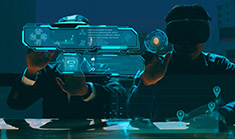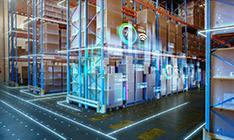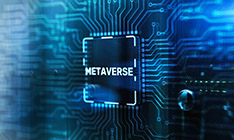Articles
The following articles provide additional resources about the Metaverse:
Metaverse Articles
How Are Industries Harnessing the Power of the Metaverse?
 In the bid to keep pace with ongoing digital transformation, various industries are joining the race to incorporate the Metaverse into their operations. Metaverse, an increasingly popular concept that refers to a mix of digital and physical worlds including augmented reality (AR), virtual reality (VR), and immersive digital environments, has become the latest trend in some industrial sectors.
In the bid to keep pace with ongoing digital transformation, various industries are joining the race to incorporate the Metaverse into their operations. Metaverse, an increasingly popular concept that refers to a mix of digital and physical worlds including augmented reality (AR), virtual reality (VR), and immersive digital environments, has become the latest trend in some industrial sectors.
The Metaverse concept offers industries leverage to go beyond conventional norms and embrace an entirely virtual environment where limitless interactions and experiences are possible. The adoption of this virtual space presents new means of customer engagement, business planning, process orchestration and many other facets of industry. The metaverse could significantly alter the traditional ways businesses interact with their customers, suppliers, and partners.
How Metaverse Is Shaping eCommerce
 The Metaverse may revolutionize eCommerce, redefining it by offering augmented customer experiences and reshaping retail experiences. It is an exciting, forward-thinking concept that presents a virtual reality space where users can interact in an immersive environment and conduct transactions. Online retail is no longer bounded by two-dimensional pictures; instead, customers walk through virtual aisles, browse through virtual showroom, and even chat with virtual avatars of sales representatives, all within the comfort of their homes.
The Metaverse may revolutionize eCommerce, redefining it by offering augmented customer experiences and reshaping retail experiences. It is an exciting, forward-thinking concept that presents a virtual reality space where users can interact in an immersive environment and conduct transactions. Online retail is no longer bounded by two-dimensional pictures; instead, customers walk through virtual aisles, browse through virtual showroom, and even chat with virtual avatars of sales representatives, all within the comfort of their homes.
The integration of the Metaverse into eCommerce can provide a seamless user experience, breaking the boundaries between the physical and the digital. The cutting-edge technology involved is already aiding some online retailers in personalizing their customer’s journey, creating an immersive shopping experience that mirrors and enhances physical store shopping.
How the Metaverse Is Shaping Consumer Behavior
 The metaverse, a convergence of virtual and physical realities, promises to rapidly transform the consumer behavior sector. As this immersive digital universe continues to evolve, it will reshape the way individuals interact, engage, and make purchasing decisions. The metaverse offers a unique blend of virtual environments, augmented reality, and immersive experiences, enabling consumers to explore, socialize, and even shop in different ways.
The metaverse, a convergence of virtual and physical realities, promises to rapidly transform the consumer behavior sector. As this immersive digital universe continues to evolve, it will reshape the way individuals interact, engage, and make purchasing decisions. The metaverse offers a unique blend of virtual environments, augmented reality, and immersive experiences, enabling consumers to explore, socialize, and even shop in different ways.
Within the metaverse, consumers can seamlessly transition between the physical and digital worlds, blurring the lines between online and offline experiences. This seamless integration allows for a more personalized and engaging shopping experience, where consumers can virtually try on clothing, explore product demonstrations, and even attend virtual events hosted by brands.
Impact of the Metaverse on the Retail Industry
 The potential impact of the metaverse on the retail industry is becoming increasingly evident as more businesses explore this digital frontier. The metaverse, defined as a connection of persistent, interactive and connected virtual environments that can be experienced by one or more people, offers unprecedented opportunities for the retail sector. One of the biggest advantages is the ability to blur the lines between the physical and digital worlds, creating immersive experiences for consumers. The metaverse provides a platform where consumers can interact with products virtually, all the while experiencing an immersive sense of physicality. As a result, the retail industry has the potential to experience a fundamental shift in how businesses interact with their customers and sell products.
The potential impact of the metaverse on the retail industry is becoming increasingly evident as more businesses explore this digital frontier. The metaverse, defined as a connection of persistent, interactive and connected virtual environments that can be experienced by one or more people, offers unprecedented opportunities for the retail sector. One of the biggest advantages is the ability to blur the lines between the physical and digital worlds, creating immersive experiences for consumers. The metaverse provides a platform where consumers can interact with products virtually, all the while experiencing an immersive sense of physicality. As a result, the retail industry has the potential to experience a fundamental shift in how businesses interact with their customers and sell products.
Retail stores, for instance, will no longer be bound by geographical location in the metaverse. Consumers can explore virtual stores with an unrivaled degree of interactivity, providing them a shopping experience that transcends the capability of traditional e-commerce. Furthermore, brands have the opportunity to engage with customers in exciting new ways. For example, they can utilize virtual events to promote products, provide customer service in a more interactive manner, or even offer unique experiences like virtual fashion shows.
The Power of Digital Twins in the Enterprise Metaverse
 The enterprise metaverse has the potential to profoundly impact businesses and organizations globally through immersive and innovative technologies like digital twins. As interactive 3D models of physical assets and processes, digital twins empower users to optimize performance, predict problems, and collaborate in real-time within digital environments.
The enterprise metaverse has the potential to profoundly impact businesses and organizations globally through immersive and innovative technologies like digital twins. As interactive 3D models of physical assets and processes, digital twins empower users to optimize performance, predict problems, and collaborate in real-time within digital environments.
When integrated with augmented reality, virtual reality, artificial intelligence, and other emerging technologies, digital twins become even more powerful and transformative. They grant unprecedented visibility into operations, unlock actionable insights, and will drive the next evolution of the connected, intelligent industrial metaverse.
Reimagining Urban Development with the Smart City Metaverse
 Imagine a virtual reality where every aspect of urban living is replicated in intricate detail. Not just a game or a social networking space but a digital twin of the physical world where real estate, infrastructure, and the overall dynamics of city planning are made accessible online. As generative AI technology evolves, this concept, known as the Smart City Metaverse, is slowly turning into reality, and it’s redefining traditional urban development.
Imagine a virtual reality where every aspect of urban living is replicated in intricate detail. Not just a game or a social networking space but a digital twin of the physical world where real estate, infrastructure, and the overall dynamics of city planning are made accessible online. As generative AI technology evolves, this concept, known as the Smart City Metaverse, is slowly turning into reality, and it’s redefining traditional urban development.
In the context of a smart city, a metaverse provides a platform for enhanced social interaction, infrastructural planning and management, and sustainable development. Here, urban planners can simulate various scenarios aimed at sustainable development goals, such as mitigating climate change impacts. The metaverse also offers ways to address the challenges of rapid urbanization, such as congested infrastructure and the public health issues, by conducting virtual testing and potential impact analysis, leading to more efficient urban infrastructure. Countless scenarios can be tested, using real or projected data, using the digital twin of a real world city.
The Role of Artificial Intelligence (AI) in the Metaverse
 The role of Artificial Intelligence (AI) in the metaverse is beginning to take center stage as the world continues to be steadily enmeshed in digital technologies. AI is acting as the catalyst driving innovation, enhancing user experiences, and powering highly interactive and immersive environments within this virtual realm.
The role of Artificial Intelligence (AI) in the metaverse is beginning to take center stage as the world continues to be steadily enmeshed in digital technologies. AI is acting as the catalyst driving innovation, enhancing user experiences, and powering highly interactive and immersive environments within this virtual realm.
The Metaverse, a virtual universe that mirrors the physical world, with its own ecosystems, economies, and social interactions, is becoming more of a reality due in part to the breakthroughs in AI. The dynamic interaction between AI and the metaverse is shaping a new era of digital existence, ushering in an age where the boundaries between the real and virtual worlds blur.
The Metaverse’s Impact on Remote Work and Collaboration
 The advent of the Metaverse is tailored to revolutionize the way businesses perceive and approach remote collaboration. The Metaverse, a virtual space enabled by converging physical, augmented, and virtual reality, offers an immersive environment that replicates the physical world. This concept is not merely a buzzword spurred by tech giants, but it holds substantial implications for the world of remote work.
The advent of the Metaverse is tailored to revolutionize the way businesses perceive and approach remote collaboration. The Metaverse, a virtual space enabled by converging physical, augmented, and virtual reality, offers an immersive environment that replicates the physical world. This concept is not merely a buzzword spurred by tech giants, but it holds substantial implications for the world of remote work.
Within the confines of this vast digital ecosystem, businesses could conduct virtual meetings that mirror close physical interaction, go beyond the constraints of geographical locations, and foster team collaborations in a more engaging manner. The norm of hybrid work can be seen embarking for a brave new world with the involvement of the Metaverse. Employees that become ‘remote workers’ in this context have the potential to enjoy a seamless work-life balance without forgoing the essence of physical meetings.
The Virtual Reality of Everyday Life – Understanding the Consumer Metaverse
 The consumer metaverse can be seen as the virtual reality of everyday life; a new and complex part of existence. In this near future digital transformation, individuals will be drawn into immersive virtual worlds with seamless integration of real and virtual elements. The consumer metaverse offers a social media-driven reality that is enhanced by advanced technology, thus creating a whole new dimension of digital experience.
The consumer metaverse can be seen as the virtual reality of everyday life; a new and complex part of existence. In this near future digital transformation, individuals will be drawn into immersive virtual worlds with seamless integration of real and virtual elements. The consumer metaverse offers a social media-driven reality that is enhanced by advanced technology, thus creating a whole new dimension of digital experience.
Today life already transcends the physical world. Metaverse marketing has promoted the idea of a new virtual reality, which mimics a parallel universe while promising infinite possibilities. Although the virtual world of the metaverse would not replace real life completely, it opens doors to novel forms of interaction and communication. The metaverse provides a user-directed combination of the real world and augmented reality, where individuals can find alternate virtual spaces to experience their favorite events, to meet people or to undertake different activities.
What Components Are Part of Metaverse Infrastructure?

Metaverse infrastructure is a multilayered foundation that encompasses an array of components. Central to this system is the concept of virtual reality. Virtual reality provides immersive and interactive experiences, allowing individuals to partake in a digital environment that in many ways feels remarkably close to real life. Virtual reality heavily relies on hardware, such as VR headsets, and software engines like Unreal Engine from Epic Games to render 3D content and facilitate a seamless virtual experience.
Another fundamental component of the metaverse infrastructure constitutes the virtual world itself. These virtual spaces are the digital realms where interactions, transactions, and experiential activities occur. The development and management of these virtual spaces relies on advanced spatial computing technologies that simulate real-world physics and 3D environments.
What Is Industrial Metaverse and Why It Is Important
 The industrial metaverse is an emerging concept drawing profound interest in modern automated workspaces, leveraging the complex interweaving of physical and digital realities. It is a virtual representation of the industrial world, extending beyond conventional metaverses to embody entire industries within its interactive, 3D and immersive environment. Utilizing technologies like artificial intelligence, the internet of things, and augmented and virtual reality, the industrial metaverse creates an accurate digital replica – or ‘digital twin’, of manufacturing processes, logistical networks, and even entire factories or industries.
The industrial metaverse is an emerging concept drawing profound interest in modern automated workspaces, leveraging the complex interweaving of physical and digital realities. It is a virtual representation of the industrial world, extending beyond conventional metaverses to embody entire industries within its interactive, 3D and immersive environment. Utilizing technologies like artificial intelligence, the internet of things, and augmented and virtual reality, the industrial metaverse creates an accurate digital replica – or ‘digital twin’, of manufacturing processes, logistical networks, and even entire factories or industries.
Its importance lies in its potential to revolutionize industries, fostering greater efficiency, productivity, and sustainability. As businesses increasingly digitize their operations, the industrial metaverse is envisioned as the nexus where these new digital practices can be tested, refined, and rendered more profitable before being implemented into the real world. By offering a real-time, interactive, and substantive understanding of complex processes and systems, it enables businesses to optimize their operations, make precise predictions, and make more informed decisions.
What Is the Impact of Smart City Metaverse on Public Safety?

The advent of the Smart City Metaverse has profound implications for public safety. This revolutionary concept combines the physical world with a virtual, immersive environment, offering new opportunities and challenges in safeguarding citizens. By leveraging cutting-edge technologies such as the Internet of Things (IoT), artificial intelligence, and virtual reality, the Smart City Metaverse aims to create a seamless integration between the digital and physical worlds, fostering enhanced security and resilience.
Public safety in the context of a Smart City Metaverse is a complex concept that encompasses various aspects of protecting citizens, infrastructure, and resources within the interconnected virtual and physical worlds. It involves the proactive prevention, detection, and response to potential threats, emergencies, and disruptive events that could compromise the well-being and security of individuals and communities.
What Is the Infrastructure of the Metaverse?
 The metaverse aims to be an immersive virtual world that seamlessly blends physical and digital realms, enabling users to interact, collaborate, and engage in a range of activities within a shared virtual environment. At the core of this revolutionary concept lies a robust infrastructure that serves as the backbone, facilitating seamless connectivity and interoperability. The infrastructure of the metaverse is an evolving, complex network of interconnected technologies, protocols, and frameworks that work together to create a unified and cohesive virtual universe.
The metaverse aims to be an immersive virtual world that seamlessly blends physical and digital realms, enabling users to interact, collaborate, and engage in a range of activities within a shared virtual environment. At the core of this revolutionary concept lies a robust infrastructure that serves as the backbone, facilitating seamless connectivity and interoperability. The infrastructure of the metaverse is an evolving, complex network of interconnected technologies, protocols, and frameworks that work together to create a unified and cohesive virtual universe.
This infrastructure encompasses a wide array of components, including high-speed networks, powerful computing resources, advanced hardware devices, and cutting-edge software platforms. It leverages the latest advancements in fields such as virtual reality (VR), augmented reality (AR), blockchain, and decentralized computing to deliver an immersive and secure metaverse experience to users worldwide.
What Role Does Spatial Computing Play in the Metaverse?

In the digital landscape of the Metaverse, spatial computing plays a crucial role, acting as the backbone of enhanced interactivity, immersion and real-time navigation. This technology transcends conventional paradigms of interaction, venturing beyond screen-based confines into engaging three-dimensional spaces that mirror physical reality. As the name implies, spatial computing is a computing paradigm built on an understanding of three dimensional space. This is in stark contrast to the vast majority of computing experiences that have been based on interactions with flat (2D) screens.
Spatial computing allows the Metaverse to evolve into a more immersive and intuitive platform, reshaping traditional concepts of digital interaction. It plays an instrumental role in the creation of a digital twin of the physical world, aiding in bridging the gap between virtual and physical environments. In the realm of the Metaverse, spatial computing makes it possible to navigate, manipulate, and interact with digital objects as one would in the real world.
Why Cities Are Exploring Metaverse Technology
 As information technology continues advancing at a rapid pace, cities around the world are beginning to explore how metaverse solutions can be integrated with physical urban infrastructure and governance systems to enhance civic life. Many municipalities envision a “Cityverse” concept that bridges both physical and virtual spaces to provide next-generation services to residents. With the metaverse market expected to reach over $800 billion by 2024, city leaders aim to future-proof their regions for the emerging digital economy and infrastructure needs that will redefine urban landscapes in the coming years.
As information technology continues advancing at a rapid pace, cities around the world are beginning to explore how metaverse solutions can be integrated with physical urban infrastructure and governance systems to enhance civic life. Many municipalities envision a “Cityverse” concept that bridges both physical and virtual spaces to provide next-generation services to residents. With the metaverse market expected to reach over $800 billion by 2024, city leaders aim to future-proof their regions for the emerging digital economy and infrastructure needs that will redefine urban landscapes in the coming years.
Early Cityverse experiments highlight a range of potential benefits, from boosting tourism with augmented and virtual reality experiences that showcase a city’s history and culture, to optimizing energy and transportation networks using real-time data and artificial intelligence. As 5G connectivity and other supporting technologies mature, Cityverse applications can scale up dramatically. For example, Seoul, South Korea unveiled an entire metaverse ecosystem in late 2022, with plans for virtual replicas of public infrastructure and simulated urban policy scenarios.

